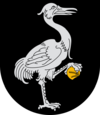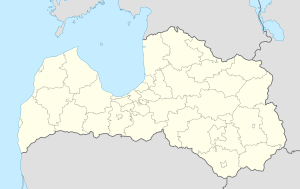Grobiņa facts for kids
Quick facts for kids
Grobiņa
|
||
|---|---|---|
|
Town
|
||
|
||
| Country | ||
| Municipality | South Kurzeme Municipality | |
| Town rights | 1695 | |
| Area | ||
| • Total | Lua error in Module:Wd at line 1,575: attempt to index field 'wikibase' (a nil value). km2 (Formatting error: invalid input when rounding sq mi) | |
| • Land | Lua error in Module:Wd at line 1,575: attempt to index field 'wikibase' (a nil value). km2 (Formatting error: invalid input when rounding sq mi) | |
| • Water | Expression error: Unexpected < operator. km2 (Formatting error: invalid input when rounding sq mi) | |
| Elevation | 20 m (70 ft) | |
| Population | ||
| • Total | Lua error in Module:Wd at line 1,575: attempt to index field 'wikibase' (a nil value). | |
| Time zone | UTC+2 (EET) | |
| • Summer (DST) | UTC+3 (EEST) | |
| Postal code |
LV-3430
|
|
| Calling code | +371 634 | |
| Number of city council members | 9 | |
Grobiņa is a town in Latvia, located in the Courland region. It's about eleven kilometers east of Liepāja. The town was first established by the Teutonic Knights in the 1200s. You can still see some parts of their old Grobina castle today. Grobiņa officially became a town in 1695.
Long ago, during the Early Middle Ages, Grobiņa was a very important place in what is now Latvia. It was a major settlement for people from Scandinavia (like Vikings!). It was similar to other famous Viking towns like Hedeby and Birka, but it might even be older. Over 3,000 ancient burial mounds (old graves) have been found here. They show us a lot about the Vendel Age (a period before the Viking Age) in Northern Europe.
Contents
Grobiņa: An Ancient Town in Latvia
Grobiņa's Viking Past
Discovering Ancient Graves
In 1929 and 1930, an archaeologist named Birger Nerman dug up the settlement at Grobiņa. He found parts of an old fort that was protected on three sides by the Ālande River. He also found three cemeteries from the Vendel Age, dating from about 650 to 800 AD.
One cemetery seemed to be for soldiers, similar to ones found in Sweden. The other two cemeteries showed that there was a community of people from Gotland (a Swedish island) living peacefully under the protection of Swedish soldiers. Nerman's discoveries suggest that Grobiņa was an early Scandinavian colony, likely from Gotland. Many flat graves belonged to women, identified as Gotland natives by their belt buckles and brooches. The burial mounds mostly held men, often buried with typical Scandinavian weapons.
The Unique Picture-Stone
In 1987, a special stone with carvings, called a picture-stone or stele, was found in one of the graves. It showed two birds that looked like ducks. These kinds of stones are usually only found in Gotland. This stone's style suggests it was made in the late 600s. One side of the stone has detailed carvings of two waterbirds with their beaks touching, surrounded by ornaments. Hundreds of these picture stones have been found in Gotland.
By the early 800s, fewer graves of women were found in Grobiņa. Later graves were mostly of Scandinavian men who traveled by sea.
A Big Battle Long Ago
The Norsemen (Vikings) might have controlled Grobiņa until the mid-800s. Around that time, the Curonians (people living in the Courland region of Latvia) rebelled. They had been paying taxes to Swedish rulers for a long time.
Around 854, a fleet of Danes tried to make the Curonians pay taxes to them instead, but the Danes were defeated. Then, Olof (I) of Sweden gathered a huge army and tried to win back the old colony. During this fight, they destroyed a place that an old writer named Rimbert called Seeburg, which is usually thought to be Grobiņa. Seeburg had 7,000 armed men defending it, but the Swedes attacked, robbed, and burned the town.
The Swedish invaders sent their ships back and traveled inland for five days. They reached a town called Apulia (today's Apuolė, about 40 kilometers to the southeast in Lithuania). Apulia had as many as 15,000 warriors. The Swedes surrounded the town for eight days but couldn't capture it. They even prayed to their Christian God for help. Just as they were getting ready for a final battle, the Curonians suddenly asked for peace. They gave the Swedes weapons and gold that they had taken from the Danes a year earlier.
Birger Nerman's digs at the old fort of Apulia confirmed this story. He found signs of a big battle in the 800s, especially many Swedish arrowheads near the walls of the old Curonian fort.
Sports in Grobiņa
Grobiņa is home to a football club called Grobiņas SC/LFS, which plays in the top football league in Latvia. However, their local stadium isn't big enough for top-level games. So, the team and their fans travel to the Daugava Stadium in Liepāja to play their home matches.
Gallery
See also
 In Spanish: Grobiņa para niños
In Spanish: Grobiņa para niños






